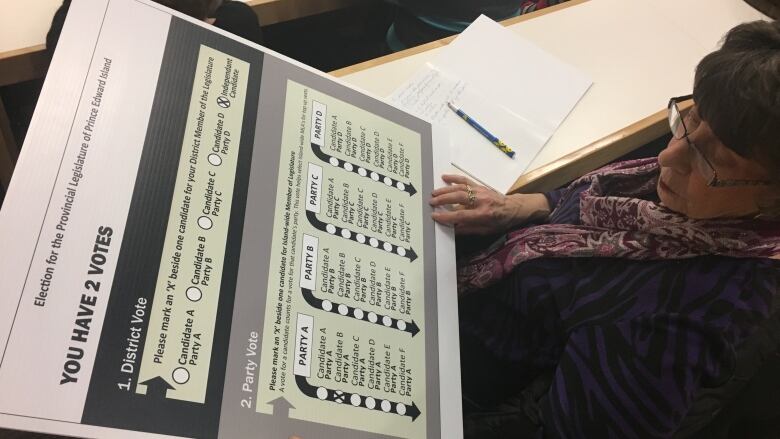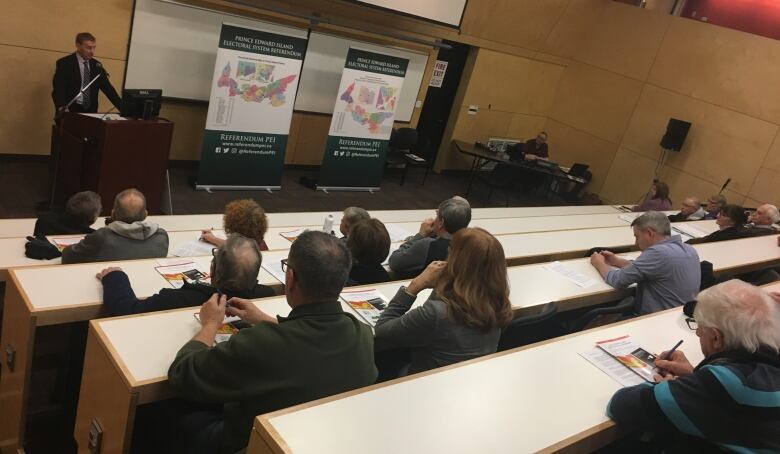Islanders drill down into mixed-member proportional
Facing 3rd vote since 2005, Islanders probe details of proposed electoral change

About 60 people attended a meeting in Charlottetown Tuesday night to ask questions and engage in some polite debate on the topic of mixed-member proportional representation and P.E.I.'s upcoming referendum on electoral reform.
The province's referendum commissioner Gerard Mitchell held the fifth of 15 scheduled public meetings Tuesday night on the campus of Holland College.
One of Mitchell's duties as commissioner is to provide public education on the referendum, and in particular on MMP, the electoral model pitted against the current first-past-the-post in the referendum, which government says will be binding.
According to one of the people attending the meeting, explaining MMP isn't easy.
Too hard for the Tim's crowd?
Douglas MacNevin said he tried explaining the system to some of the "old guys" in his crowd at Tim Horton's.
"They're pretty smart people, and I thought I was kind ofhalf-smart too," he said, but MacNevin added his explanation fell short.
"The devil's in the details," he concluded, noting not all the details on the proposed model have been fleshed in government's legislation setting out the rules for the referendum.
But others at the meeting found lots of detail to dig into on the proposed electoral system. MMP is used in countries around the world but so far has been unable to gain a foothold in Canada after being rejected in plebiscites in B.C., Ontario, and in P.E.I. in 2005.
MMP topped 2016 plebiscite
This will actually be the third time Islanders have been asked to consider a proportional system of government.
In 2016 five options were put forward in a plebiscite. MMP came out as the top choice ahead of first-past-the-post.
Premier Wade MacLauchlan called the result debatablegiven turnout of just 36 per cent, setting the stage for the upcoming referendum.
Several questions at the meeting revolved around party lists that make up the second part of what would be a two-part ballot.

On the first part of their ballot, Islanders would vote for a candidate in their local district as they do now, and the results would be tabulated in each district using first-past-the-post. Eighteen seats would be decided that way in 18 individual districts.
The second part of the ballot would include lists of up to ten candidates for each party, with voters asked to vote for a single list candidate.
Switch to 'open-list' ballot
That's the biggest change from the MMP model Islanders voted down in 2005; that used a "closed-list" ballot where, on the second portion, voters chose just their party of choice, and the parties had more say in which of their list candidates could be elected.
As Mitchell pointed out Tuesday, with the current open-list proposal, list candidates would be elected based on the number of votes each candidate receives.
Nine list candidates would be added to the legislature from the lists in order to try to make the percentage of overall seats each party has in the house equal to the proportion of votes they received on the second ballot.
When asked how parties will choose candidates for their lists, Mitchell said they would be likely to write that process into their party constitutions, as they have regarding the process they currently use to select candidates.
Results binding, but not
In response to a question about whether the results of the referendum would be binding, Mitchell responded that's what the legislation says, but added "a new government could come in and change the legislation.
"If a government has jurisdiction to make the legislation, government also has jurisdiction to change the legislation. So it's possible you could get a new government in place and say, 'No we're not going to do that at all.'"
Government has said that for the result to be considered binding, the yesor the nocampaign has to win not just more than 50 per cent of the overall votes, but it also has to win in 60 per cent of P.E.I.'s districts. As Mitchell calculated, that works out to 17 out of 27 districts.
When asked why that threshold was set, Mitchell said "I don't know. That's what the legislation says. ...I don't know why, I'm not a member of the legislature."
"That's like another kind of barrier to this going through," commented one woman at the meeting.
Referendum date up in the air
The referendum will be held in conjunction with the next provincial election, so Mitchell doesn't know its date.
That means he also doesn't know when the referendum period would begin. The official referendum period will bring tighter restrictions on referendum advertising and fundraising by advocacy groups.
Mitchell explained cabinet will set the start of the referendum period up to eight months before the election is held, although the referendum period and the election period could also begin simultaneously, lasting as few as 26 days.












_(720p).jpg)


 OFFICIAL HD MUSIC VIDEO.jpg)
.jpg)



























































































